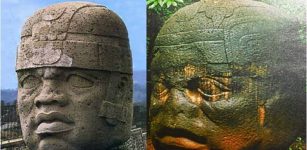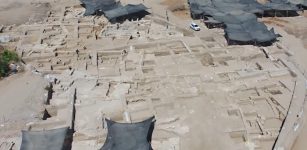The Amarna Letters: Diplomatic Correspondence In Ancient Egypt
A. Sutherland - AncientPages.com - Amarna Letters also known as Amarna Tablets are mostly diplomatic letters (with a few myths and epics) dated to an interesting, historical period in ancient Egypt, related to the reigns of pharaoh Akhenaten of the 18th Dynasty of Egypt and his wife Nefertiti, and Amenhotep III (1402-1364).
In 1887, local Egyptian peasants found a few tablets in the Akhenaten’s palace complex ruins.
Amarna Akkadian letter. Image credit: Capmo - Public Domain
Famous English Egyptologist William Matthew Flinders Petrie (1853 – 1942), was one the first excavators of the Amarna Tablets in 1891-92; later other archaeologists helped to reveal the rest of the documents.
There are 382 tablets written in cuneiform characters and 350 of them are letters), which can be found in museums of Berlin, London, and Cairo. The documents are written in the Akkadian language.
The Amarna Tablets were found in Amarna, now an archaeological site located near the modern city of Tell-Amarna (“Hill at El-Amarna”), with the remains of Akhenaten’s ancient capital.
They constitute a very important historical documents and reflect a cosmopolitan culture of the region, the so-called a "cuneiform culture" that throughout most of the second millennium extended to the east of Assyria and Babylonia, the Fertile Crescent, over into Asia Minor.
The Amarna letters still remain documents of the highest importance because they provide the rich evidence they provide for the social and political history of Syria and Palestine in the fourteenth century BC.
The tablets were diplomatic letters sent to Egypt from abroad, from the kings of Babylonia, Assyria, Hittites in Eastern Asia Minor, Mittani, and Cyprus. However, most of this correspondence was sent from vassal rulers in the neighboring region as for example from Ugarit, Syria-Palestine (Canaan, Lebanon, Ugarit, and the lands located in the region of the eastern part of the Mediterranean Sea.
The documents deal with a variety of subjects, such as exchange of gifts between rulers, news about events in distant Phoenician cities: Byblos, Tyre, various requests regarding food, military affairs, and diplomatic marriages.
There are also diplomatic letters dealing with serious concerns about military threats. A few tablets from Amarna are covered with legends and myths. There is, for example, the famous myth about Nergal and Ereshkigal, a famous, passionate love story that takes place in the Mesopotamian Underworld.
In 1992, William L. Moran (1921 – 2000), an American Assyriologist, translated the 350 Amarna Letters into English for the first time.
Written by – A. Sutherland - AncientPages.com Senior Staff Writer
Updated on June 19, 2023
Copyright © AncientPages.com All rights reserved. This material may not be published, broadcast, rewritten or redistributed in whole or part without the express written permission of AncientPages.com
Expand for referencesMore From Ancient Pages
-
 Meteora – A Sanctuary Of Harmony And Quietness “Hanging” In The Sky
Civilizations | Aug 14, 2015
Meteora – A Sanctuary Of Harmony And Quietness “Hanging” In The Sky
Civilizations | Aug 14, 2015 -
 Belenus: Mighty Gaulish God Of Light Often Associated With Lugh And Apollo
Celtic Mythology | Feb 6, 2020
Belenus: Mighty Gaulish God Of Light Often Associated With Lugh And Apollo
Celtic Mythology | Feb 6, 2020 -
 The Enigma Of The ‘Ancient Ones’, The Anasazi Cliff-Dwellers Of The Southwestern United States
Civilizations | Apr 9, 2017
The Enigma Of The ‘Ancient Ones’, The Anasazi Cliff-Dwellers Of The Southwestern United States
Civilizations | Apr 9, 2017 -
 Rare, Well-Preserved Medieval Bone Flute Found In Kent
Archaeology | Nov 24, 2022
Rare, Well-Preserved Medieval Bone Flute Found In Kent
Archaeology | Nov 24, 2022 -
 The Olmecs – Who They Were, Where They Came From Still Remains A Mystery
Civilizations | Feb 19, 2015
The Olmecs – Who They Were, Where They Came From Still Remains A Mystery
Civilizations | Feb 19, 2015 -
 Unique Bones Decorated With Black Markings Discovered In 4,500-Year-Old Tomb In Ukraine
Archaeology | Jul 30, 2018
Unique Bones Decorated With Black Markings Discovered In 4,500-Year-Old Tomb In Ukraine
Archaeology | Jul 30, 2018 -
 Monster Water God Gong Gong Blamed For Cosmic Catastrophes In Chinese Myths
Chinese Mythology | Nov 2, 2020
Monster Water God Gong Gong Blamed For Cosmic Catastrophes In Chinese Myths
Chinese Mythology | Nov 2, 2020 -
 Why Were Medieval People Easily Offended And Scared Of Rumors?
Ancient History Facts | Oct 14, 2019
Why Were Medieval People Easily Offended And Scared Of Rumors?
Ancient History Facts | Oct 14, 2019 -
 On This Day In History: HMS Challenger Begins Scientific Exploration Of Oceans – On Dec 21, 1872
News | Dec 21, 2016
On This Day In History: HMS Challenger Begins Scientific Exploration Of Oceans – On Dec 21, 1872
News | Dec 21, 2016 -
 Is A Viking Ship Hidden In The Colorado Desert?
Featured Stories | Jan 8, 2018
Is A Viking Ship Hidden In The Colorado Desert?
Featured Stories | Jan 8, 2018 -
 World’s Largest Wine Factory From The Byzantine Period Unearthed In Yavne
Archaeology | Oct 14, 2021
World’s Largest Wine Factory From The Byzantine Period Unearthed In Yavne
Archaeology | Oct 14, 2021 -
 900-Year-Old Crypt At Old Dongola: Magical Inscriptions And Mysterious Signs Found
Archaeology | Sep 12, 2015
900-Year-Old Crypt At Old Dongola: Magical Inscriptions And Mysterious Signs Found
Archaeology | Sep 12, 2015 -
 Thousands Magnificent Jade Artifacts Discovered In Han Dynasty Tombs – China’s Golden Age In New Light
Archaeology | Jul 23, 2020
Thousands Magnificent Jade Artifacts Discovered In Han Dynasty Tombs – China’s Golden Age In New Light
Archaeology | Jul 23, 2020 -
 Our Lives Have Always Been Manipulated By Money – Part 2
Featured Stories | Jun 4, 2022
Our Lives Have Always Been Manipulated By Money – Part 2
Featured Stories | Jun 4, 2022 -
 Aztec Treasure: ‘Yew Of Gold’ Found 39 Years Ago Originates From Spanish Plunder During ‘Sad Night’ In 1520
Archaeology | Jan 12, 2020
Aztec Treasure: ‘Yew Of Gold’ Found 39 Years Ago Originates From Spanish Plunder During ‘Sad Night’ In 1520
Archaeology | Jan 12, 2020 -
 On This Day In History: Sack Of Rome Took Place on May 6, 1527
News | May 6, 2016
On This Day In History: Sack Of Rome Took Place on May 6, 1527
News | May 6, 2016 -
 Mystery Of The Ancient Red Sign Witnessed In The Sky Over Japan
News | Mar 31, 2020
Mystery Of The Ancient Red Sign Witnessed In The Sky Over Japan
News | Mar 31, 2020 -
 Boreas – Mighty North Wind God In Greek Mythology
Featured Stories | Mar 26, 2023
Boreas – Mighty North Wind God In Greek Mythology
Featured Stories | Mar 26, 2023 -
 Strange Tales Of Loughareema – The Vanishing Lake Where People Are Lost
Featured Stories | Jan 8, 2022
Strange Tales Of Loughareema – The Vanishing Lake Where People Are Lost
Featured Stories | Jan 8, 2022 -
 2000-Year-Old Antikythera Mechanism – Experts Recreate A Mechanical Cosmos For The World’s First Computer
Ancient Technology | Mar 15, 2021
2000-Year-Old Antikythera Mechanism – Experts Recreate A Mechanical Cosmos For The World’s First Computer
Ancient Technology | Mar 15, 2021

